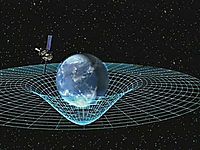
Photo from wikipedia
Displacements of the base during trajectory tracking are a common issue in the control of aerial manipulators. These are caused by reaction torques transferred to the base due to the… Click to show full abstract
Displacements of the base during trajectory tracking are a common issue in the control of aerial manipulators. These are caused by reaction torques transferred to the base due to the manipulator motion and, in particular, to the motion of its center of gravity. We present a novel approach to reduce base displacements of a kinematically redundant aerial manipulator by using null-space projection in the inverse kinematic control. A secondary objective function minimizes the horizontal displacement of the manipulator center of gravity. We test this algorithm on different trajectories for both three and four degrees of freedom (DOF) manipulators in a simulation environment. The results comparing our algorithm with inverse kinematic control without the null-space projection show up to an 80% reduction in the end-effector position error and an average of about 56% reduction in maximum base displacement. The simulation implementation also runs faster than in real-time in our code implementation. We provide a workspace analysis based on multiple stopping criteria such as excessive base displacement, joint velocities and end-effector position error for the 3 and 4 DOF manipulators. As expected, the 4 DOF manipulator has a larger workspace.
Journal Title: Robotics
Year Published: 2023
Link to full text (if available)
Share on Social Media: Sign Up to like & get
recommendations!